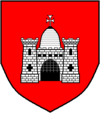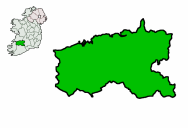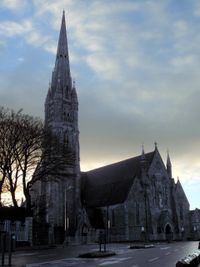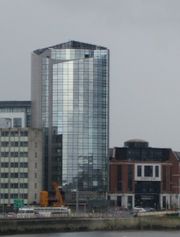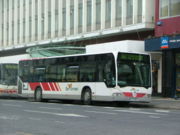Limerick
2007 Schools Wikipedia Selection. Related subjects: European Geography
Limerick ( Irish: Luimneach: Lom na nEach - the bare place - i.e. open ground - of the horses) is a city and the county seat of County Limerick in the province of Munster, in the midwest of the Republic of Ireland. The city lies on the River Shannon, with three main crossing points near the city centre.
The population of Limerick including the immediate suburbs and environs is 93,321 (based on the 2002 census carried out by the CSO), which would rank it as the third biggest city in the Republic of Ireland; however, the official population of the city itself according to the city boundary laws is 52,560, according to the most recent census of 2006. This figure has remained virtually unchanged for 25 years, and places it as the fourth largest city in the Republic of Ireland after Dublin, Cork and Galway, and the fifth largest urban area on the island of Ireland (after Dublin, Belfast, Cork and Derry).
Limerick is at the centre of the Midwest region which contributes €8.224 billion (2002) towards Irish GDP. It is situated 195 km west of Dublin and is equidistant at 105 km from the cities of Cork to the south and Galway to the north.
History
The city dates from at least the Viking settlement in 812, but study suggests the presence of earlier settlements in the area. The Normans redesigned the city in the 12th century and added much of the most notable architecture, such as King John's Castle and St Mary's Cathedral. During the civil wars of the 17th century, the city played a pivotal role, besieged by Oliver Cromwell in 1651 and twice by the Williamites in the 1690s. Limerick grew rich through trade in the late 18th century, but the Act of Union in 1800, and the famine caused a crippling economic decline broken only by the so-called Celtic Tiger in the 1990s. The Waterford and Limerick Railway linked the city to the Dublin- Cork main line in 1848 and to Waterford in 1853. The opening of a number of secondary railways in the 1850's and 1860's developed Limerick as a regional centre of communications.
Governance
Limerick City Council has responsibility for certain local services such as sanitation, planning and development, libraries, collection of motor taxation, local roads and social housing. The City Council comprises elected ward councillors (formerly termed Aldermen) with an appointed (full time) CEO as City Manager. The councillors annually elect a Mayor to chair the council and represent the City. As of 2006 the current Mayor is Councillor Joe Leddin; previous Mayors include TDs Donagh O'Malley, Stephen Coughlan, Michael Lipper, Jim Kemmy and Jan O'Sullivan.
Despite the rapid growth of the city environs, the city borders have not been changed since the 1960's. A large proportion of what is considered as the population of Limerick City now live in suburbs built after the 1960's and are thus in the Limerick County Council administrative area. These include much of Caherdavin, Dooradoyle, Castletroy — including the University, Gouldavoher, and Raheen. There are ever-increasing political demands from City Councillors for a redrawing of the boundary , which is generally deemed antiquated and inaccurate for modern-day Limerick.
For national Dáil elections Limerick city is included in the Limerick East constituency which elects five members on a proportional representation system. For European parliament elections Limerick is included in the South Ireland constituency which elects three representatives.
Between April 15 1919, and April 27, 1919 the city had a period of socialist self-rule, which was called the Limerick Soviet (which was parodied several times by the satirical RTE Radio 1 program Scrap Saturday).
Architecture
The city centre is divided between the traditional areas of "English Town" on the southern end of King's Island, which includes the castle, "Irish Town" which includes the older streets on the south bank, and the current economic centre called "Newtown Pery". Newtown Pery was built in the late 18th century before the Act of Union and, unusually for an Irish city and unique in Limerick itself, this area is laid out on a grid plan. Limerick city centre is changing rapidly, with the construction of several modern high-rise buildings in the early-2000s. The suburban regions, where the majority of the population now live, have grown out from the centre along the main roads to Ennis (North Circular and Ennis Road areas/ Caherdavin), Dublin ( Castletroy and the University) and Cork (Ballinacurra/Dooradoyle/ Raheen). Suburban houses are generally two floor semi-detached homes for single families. These were built from the 1960s onwards in large estates by government projects and commercial developments, although there are many examples of Edwardian and older 1930s suburban homes on the main suburban thoroughfares leading towards the city (North & South Circular, Ballinacurra Road, O'Connell Avenue).
Much Georgian architecture was evident in the city from about the 1800s onwards. Although some has since been demolished, much of the Newtown Pery area is built in the Georgian fashion. Other architectural buildings of note in the city are King John's Castle and St Mary's Cathedral in English Town and St John's Cathedral, designed by the notable Victorian architect, P.C Hardwick (1822-1892). St Mary's Cathedral, at over 800 years old, is one of the oldest in Ireland. St John's Cathedral, whilst more modern, has one of the tallest steeples.
One of Ireland's most celebrated museums, the Hunt Museum, is based in the historic 18th-century former Custom House. The museum was established to house an internationally important collection of approximately 2000 works of art and antiquities formed by John and Gertrude Hunt during their lifetimes. On display are the 9th century Antrim Cross, a sketch by Picasso and a bronze sculpture of a horse, said to be from a design by Leonardo da Vinci.
Transport
Buses
Local public transport is provided by Bus Éireann, Ireland's national bus operator. City Service Routes are as follows (frequencies shown in brackets, in minutes):
- 301 City Centre to Shannon Banks or Westbury (301A) (30mins)
- 302 City Centre to Caherdavin (302A Caherdavin-to-University) (20)
- 303 Carew Park to Ballynanty (30)
- 304 City Centre to Raheen (Services via Greenfields operate as 304A) (10)
- 305 Lynwood to Coonagh Roundabout (30–60)
- 306 Craeval Park to O'Malley Park (30)
- 308 City Centre to University (Services via Pennywell operate as 308A) (15)
- 309 Pineview to St. Mary's Park (60)
- 312 City Centre to Ballycummin (60).
Buses also run to towns and villages in the county and to Shannon Airport. Intercity and international buses leave from the Bus Éireann bus station adjoining the City's train station. These include hourly services to Dublin, Cork and Galway and others cities, as well as a daily service to London via ferry services from Rosslare Europort.
Rail
Iarnród Éireann's Colbert Station is the terminus for frequent services to Dublin and Cork (serving many intermediate stations), a frequent all-day commuter service to Ennis, as well as a three-times daily service to Waterford and stations in County Tipperary. Services to and from Nenagh on the Ballybrophy line will be expanded to include commuter service from 2007. There are also plans to reopen the Western Railway Corridor to Galway and Sligo, closed in the 1970's. In February 2006 it was announced that regular services between Limerick and Galway will be restored in 2007 . There are also plans to reopen Sixmilebridge station shortly after. Many rail services include a changeover at Limerick Junction. The Railway Procurement Agency has suggested that a tram system should be built in the city .
Flight
Shannon International Airport, 20 km west of the city in County Clare, has scheduled flights to many European and North American destinations. Airlines using the airport include Ryanair, Aer Lingus and American Airlines. There is currently no rail link to this airport. The Coonagh airfield, a few kilometers north of Caherdavin, provides access for small private aircraft. Cork Airport is also a option, although it is roughly a two-hour drive from the city.
Education
Limerick is an important centre of higher education in Ireland after Dublin and Cork, having its own university and several colleges.
The University of Limerick (UL), which is situated about 5 km east of the city centre in the suburb of Castletroy, is an internationally renowned centre for engineering, information technology, materials science, sports science, humanities, social sciences, and music. The Irish World Music Centre specialises in traditional music and dance, and UL is host to the Irish Chamber Orchestra. It has a student population of over 12,000.
Limerick Institute of Technology (LIT), based about 3 km north-west of the city centre, is an important centre for business, engineering, information technology, Humanities and science education. It also has a broad range of art and design courses, offered at Limerick School of Art and Design – its Clare Street campus (near the city centre). It has a student population of C. 6,500 students
Mary Immaculate College, Limerick (technically a part of the University of Limerick), is an education and arts college situated just south-west of the city centre. Thomond College of Education, Limerick was a successful teacher training college (for secondary level) and was integrated into the university in 1991.
Primary and secondary education in the city is organised similarly to the rest of Ireland.
Tourism
Limerick City is one of the countrys main tourist destinations, the city is only a 15 minute drive from Shannon International Airport. Currently tourism is growing at a spectacular rate with over 1,000 new beds being opened in the city in 2006 thanks to the opening of 5 new hotels. The city is the first to provide visitors to the city with 'Street Ambassadors', people designated to help others around and make the stay in Limerick more enjoyable.
When in Limerick, there's plenty to keep visitors occupied including King John's Castle (1212), St. Mary's Cathedral, Limerick (1168), Hunt Museum, Tours ( Angela's Ashes walking tour of Limerick City, Hop on-Hop off Sightseeing tour of Limerick City, The historical walking tour of Limerick and Boat tours along the River Shannon *Not all tours are operational year round*), Georgian house and gardens, Treaty Stone, and more in the city centre. University of Limerick is worthy of a visit at term time being a cultural hub in the suburb of Castletroy. Also a visit to Bunratty Castle and folk park, Adare village and the Foynes Flying Boat Museum (all on the outskirts of the city) are must see attractions.
Economy
Limerick is at the heart of the region dubbed "the Midwest". Also known as the "Shannon Region", this is primarily an economic and social concept. The region encompasses County Limerick, County Clare, North County Tipperary and Northwest County Kerry, with its focal point centred on Limerick and its environs within an eight kilometre (5 mile) radius
The area is possibly the main economic region outside of Dublin and Cork. Its economic success has been driven in part by the University of Limerick, Shannon Airport in Co. Clare and Shannon Development (an economic development agency), whose precursor was SFADCO (Shannon Free Airport Development Company), an economic agency that provided tax incentives to companies locating in the area surrounding Shannon Airport. As of 2006 Shannon Development are mostly concerned with disposing of valuable industrial park properties.
Historically Limerick was an agricultural commodity-driven economy, due its position as the first major port along the River Shannon. The city was one of the main meat processing areas in Ireland, and industry included confectionery and flour production. In line with the changing economic landscape in Ireland, many multinational companies are now based in Limerick. Dell have their main European Manufacturing Facility in Raheen Business Park, currently producing 30,000-60,000 units per day for export to the EMEA, and are one of the largest employers in the midwest region . This contributes 5.8% of Irish GDP (2002). Analog Devices have their European manufacturing base also in Raheen, 3 km south-west of the city centre. The site employs more than 1,000 people. Johnson & Johnson subsidiary Vistakon also have a large facility in Castletroy - one of the largest contact lens manufacturing plants in the world, located in the National Technology Park.
Retail
The service industry is an important employer in the city. The city centre is one of the main shopping areas, with the pedestrianised Cruises Street being one of the main shopping streets and the soon to be finished Bedford Row. Each side of the city has outlying shopping areas. Just before Raheen is the Crescent Shopping Centre, Caherdavin has a new Jetland Shopping Centre, opened in 2005 beside the old Jetland centre (featuring a 24-hr Dunnes Stores), and Castletroy has the relatively new Castletroy Shopping Centre, with the Parkway Shopping Centre situated closer to town at the end of the Childers Road. The first two extensive retail parks in the city, the Parkway Retail Park (opened 2002) and Childers Road Retail Park (opened 2005), are located near this shopping centre. A third retail park, CityEast Retail Park opened in late 2005 on the Tipperary Road.
In April 2007, Coonagh Cross Shopping Centre will be opened. It will be the biggest shopping centre in the Mid-West region. A city-centre shopping centre of a similar scale (billed in some places as prospectively the biggest in Munster) is also planned. The Opera Centre would be located parallel to Rutland and Patrick Street, from the (Abbey River) quays to Ellen Street. This will be the first major leap of faith by external developers in Limerick City Centre as up to now the city has been all but passed over leaing the majority of development to locals. The proposed redevelopment of the entire Arthur's Quay Area, New Docklands twinned with a newly vibrant night economy helped in no small way by international tourists using Budget Flights from Shannon Airport and centered mainly around the Trinity Rooms complex at the Granary Building have given Limerick a new confidence, which should ensure that its upward path continues for the forseeable future.
Hospitals
- Mid Western Regional Hospital
- St John's Hospital
- Barringtons Hospital
- Croom Orthopaedic Hospital
Climate
Limerick has a mild climate, with the average daily maximum in July at 23°C (73.4°F) and the average daily minimum in January at -4°C (24.8°F). The highest temperature recorded in the city was 31.6°C (88.88°F), and the lowest was -11.2°C (11.84°F).
| Jan | Feb | Mar | Apr | May | Jun | Jul | Aug | Sep | Oct | Nov | Dec | Year | ||
|---|---|---|---|---|---|---|---|---|---|---|---|---|---|---|
| Average daily maximum temperature ( °C) | 11 | 11 | 13 | 15 | 18 | 20 | 23 | 23 | 19 | 17 | 12 | 11 | 16.1 | |
| Average daily minimum temperature ( °C) | -4 | -1 | 0 | 3 | 6 | 8 | 11 | 9 | 8 | 5 | 2 | 1 | 3.3 | |
| Mean total rainfall ( mm) | 100 | 70 | 70 | 60 | 60 | 60 | 60 | 80 | 80 | 90 | 90 | 100 | 920 | |
| Source: Yahoo! Weather | ||||||||||||||
Crime
The city's crime problem has been the subject of much adverse publicity; media articles often refer to Limerick as "Stab City", due to a perceived problem with knife attacks. In 2001, the then Deputy State Pathologist Dr Marie Cassidy told the Irish Medical Organisation that Limerick deserved its moniker as 40% of all stabbings in the country, in the previous year, had occurred in Limerick. This characterisation is dismissed by the city's communications officer, Mary Dundon, as 'inaccurate' and 'outdated'. According to official statistics from An Garda Síochána, Limerick county had the second-highest crime rate for headline offences in 2005, after the Dublin Metropolitan Region.
Recent years have seen serious crimes in Limerick being linked with feuds between criminal gangs within certain areas of the city, mainly Moyross, Southill and St. Mary's Park. Arguably, this rivalry was precipitated by the murder of alleged gang member Eddie Ryan in November 2000, in a public house in the Johnsgate area of the city.
Despite a relative lull in gang violence between 2004 and the first half of 2006 in Limerick's housing estates, the problem seems to have escalated again in September 2006, with two children suffering extensive burns in the torching of their mother's car in early September, and a series of apparently retaliatory attacks including a drive-by shooting later that month.
Twinned Cities
Limerick is twinned with Quimper in France and Spokane, Washington in the United States. In 2006 it was announced that the city would twin with New York City in the U.S..
Trivia
|
